The limits of the graphic narrative of migration in the public media discourse and the human rights approach
Main Article Content
Abstract
Article Details
Universitas-XXI Journal aligns with the principles of open access and academic collaboration by adopting the Creative Commons Attribution-NonCommercial-ShareAlike 4.0 International License (CC BY-NC-SA 4.0). This license ensures that published content can be used and shared widely under the following conditions:
Attribution: Authors and the journal must be appropriately credited as the original creators of the content, with full reference and a link to the publication provided.
Non-commercial use: Content may not be used for commercial purposes, preserving its academic and educational intent.
ShareAlike: Derivative works must be distributed under the same terms as this license, promoting the creation of accessible and equitable knowledge.
By implementing this license, the Universitas-XXI Journal strengthens its commitment to disseminating high-quality research, providing free access to knowledge, and fostering a collaborative environment among researchers, educators, and students worldwide.
This decision reflects core values of responsibility, ethics, and transparency in academia, ensuring that intellectual contributions serve as a foundation for new research and projects while respecting the rights of authors and the scientific community.
For more information about this license, please visit the following link: https://creativecommons.org/licenses/by-nc-sa/4.0/"
References
Ahumada, V. (2020). El lenguaje visual de la novela gráfica Emigrantes de Shaun Tan. LIJ Ibero Revista de Literatura Infantil y Juvenil Contemporánea, (10), 46-59.
Altheide, D.L. y Snow, R.P. (1979). Media Logic. Beverly Hills: Sage.
Boum, J. (2021). Telling refugees’ stories: Testimony and hospitality in graphic novel L’Odyssée d’Hakim by Fabien Toulmé. Crossings: Journal of Migration & Culture, (12), 301-313. https://doi.org/10.1386/cjmc_00033_1
Brown, R. (2012). Migration Chronicles: Reporting on the Paradoxes of Migrant Visibility. Textos Híbridos. Revista de estudios sobre la crónica latinoamericana 2(1), 63-86.
Browne, R. & Castillo, A. (2013). Critical Discourse Analysis of intercultural representation in Chilean press. Convergencia, 20(62), 13-43.
Butler, J. (2004). Precarious Life: The Powers of Mourning and Violence. New York: Verso.
Castilleja, D. (2023). Delinear la frontera México-Estados Unidos: cinco propuestas desde la narrativa gráfica y el cómic. Ocnos: revista de estudios sobre lectura, 22(1). https://doi.org/10.18239/ocnos_2023.22.1.332
Callejo, M. (2015). Barbie Zelizer y Karen Tenenboim-Weinblatt (Ed.),(2014): Journalism and memory, Empiria. Revista de Metodología de las Ciencias Sociales, (30), 221-223.
Corbetta, M. V. (2021). Descentrar lo humano. Una propuesta de lectura de Shaun Tan desde la ecocrítica para la escuela secundaria. Catalejos. Revista sobre lectura, formación de lectores y literatura para niños, 7(13), 97-120.
Díaz, I. (2019). Historias de afuerinos: libro reúne doce crónicas gráficas de Francisco Olea. El Mercurio on line, 03 de enero de 2019. Disponible en: bit.ly/482RR3Y
Doña Reveco, C. (2022) Immigrant Invasions to the South American Tiger: Immigration Representations in Chilean Newspapers (1991–2001), Journal of Immigrant & Refugee Studies. https://doi.org/10.1080/15562948.2022.2132570
Eisner, W. (1990) Comics and Sequential Art, Tamarac, FL: Poorhouse Press.
Galindo, S. (2019). Words matter: Representation of Mexican immigrants in newspapers from Mexico and the United States. Migraciones Internacionales, 10, 1-21. https://doi.org/10.33679/rmi.v1i1.2024
Greene, F. & Zúñiga, V. (2024). Discursividades económicas sobre la inmigración en Chile en el Diario Financiero, El Mercurio de Santiago (Economía y Negocios) y La Tercera (Pulso). Anuario Electrónico De Estudios En Comunicación Social "Disertaciones", 17(1). https://doi.org/10.12804/revistas.urosario.edu.co/disertaciones/a.13541
Hamui Sutton, S. (2009). Interpretaciones literarias como apertura hacia el universo del “otro”: un acercamiento crítico a algunos cuentos de Jacobs, Poe, Rulfo, García Márquez y Cortázar. Ciudad de México: Universidad Iberoamericana.
Ivanova, A., Jocelin, J., & Samaniego, M. (2022). Los inmigrantes en la prensa chilena: lucha por protagonismo y racismo encubierto en un periódico gratuito. Comunicación y medios, 31(46), 54-67. http://dx.doi.org/10.5354/0719-1529.2022.67412
Kuechenmeister, Bobby (2009). Reading Comics Rhetorically: Orality, Literacy, and Hybridity in Comic Narrative. Scan Journal 6 (1).
Lonna Olvera, I. (2011). El libro álbum. Lecturas desde el diseño. Ciudad de México: Universidad Iberoamericana.
Nayar, P. (2021). The Human Rights Graphic Novel: Drawing it Just Right. Nueva York: Routledge.
Póo Figueroa, X. (2009). Imaginarios sobre inmigración peruana en la prensa escrita chilena: una mirada a la instalación de la agenda de la diferencia. Revista F@ ro, 1(9).
Reguillo, R. (2000). Textos fronterizos La crónica: una escritura a la intemperie. Guaraguao, 4(11), 20-29.
Reyes Zaga, H. (2019). Cartografías literarias: anotaciones a propósito de la novela de migración mexicana. Literatura mexicana, 30(1), 141-170. https://doi.org/10.19130/iifl.litmex.30.1.2019.1162
Sperb, P. y Boff, F. (2021). Jornalismo em quadrinhos sobre a crise migratória na trilogia “A Odisseia de Hakim”, de Fabien Toulmé. Revista Pauta Geral-Estudos em Jornalismo, Ponta Grossa e2117765, 1-5.
Stefoni, C. y Brito, S. (2019). Migraciones y migrantes en los medios de prensa en Chile: la delicada relación entre las políticas de control y los procesos de racialización. Revista de Historia Social y de las Mentalidades, 23(2), 1-28. https://doi.org/10.35588/rhsm.v23i2.4099
Sklodowska, E. (1997). Spanish american testimonial novel. Some afterthoughts. New York/London: Garland Publishing.
Stefoni, C., Silva, C., & Brito, S. (2019). Migración venezolana en Chile. La (des) esperanza de los jóvenes. L. Gandini, F. Lozano y V. Prieto (Coords.), Crisis y migración de población venezolana. Entre la desprotección y seguridad jurídica en Latinoamérica, 259-284. bit.ly/42oYaNU
Swanson, E. & A. Schultheis (2013). Introduction: Human rights and literature: The development of an interdiscipline. En Theoretical Perspectives on Human Rights and Literature. New York: Routledge, 1-16.
Tan, S. (2007). Emigrantes. Granada: Barbara Fiore Editora.
Thornton, P.H., Ocasio, W. y Lounsbury, M. (2012). The Institutional Logics Perspective. A New Approach to Culture, Structure and Process. Oxford: Oxford University Press
Tijoux, M., (2016). Racismo en Chile. La piel como marca de la inmigración. Santiago: Editorial Universitaria
Toffano, G., & Smets, K. (2023). Refugee hybrid fiction: Rhetorical, generic and intermedial hybridity as strategies of political resistance. Crossings: Journal of Migration & Culture, 14(2), 177-195. https://doi.org/10.1386/cjmc_00082_1
Toulmé, F. (2022). La Odisea de Hakim. 1. De Siria a Turquía. Barcelona: Bruguera / Penguin Random House.
Weber, W. & Rall, H.M (2017). Authenticity in comics journalism. Visual strategies for reporting facts, Journal of Graphic Novels and Comics, 8(4), 376-397. https://doi.org/10.1080/21504857.2017.1299020

